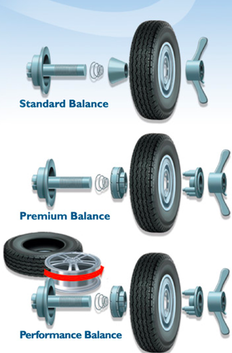
Have you ever had a problem with a vibration in your car or through the steering wheel? At Underwood Tyres & Wheels we know how irritating this can be.
The Underwood Tyres Balance Optimisation Systems were designed to serve you better. These systems will ensure that you have the smoothest driving possible.
To achieve a smooth vibration free drive, the wheel must be centered and positioned on the balancer just as it will be centered and positioned on your vehicle.
To ensure this, the tyre and wheel are balanced to the machine using a Duo Expert Adaptor & flange plates.

Why have your wheels balanced using the Underwood Tyres BOS System?
CLICK HERE FOR PRICING

Standard Balance
Tyre and Wheel are mounted to the balancing machine using the rear cone and held by the front wing nut clamp.
Premium Balance
Wheel is centred and positioned on the balancer, as it would be on your vehicle, using a Duo Expert Adapter Et Flange plate to obtain a smooth vibration free drive.
Performance Balance
To achieve optimum performance, we first balance the wheel then match the tyre and wheel to be in their optimum positions. This minimises imbalance. The tyre and wheel unit is then balanced using the Duo Expert Adaptor a Flange plate, ensuring the best in terms of ride comfort and tyre wear.
The benefits offered by the Underwood Tyres Balance Optimisation System are:
- Extended tyre life
- Improved Driver Comfort
- Less wear on steering and suspension components
- Enhanced vehicle safety
- Reduced driver fatigue
What is wheel balancing?
The purpose of wheel balancing is to evenly distribute the weight of a tyre and
all other wheel components. This ensures smooth performance and balanced
connection between the tyre and the road.
- Small metal attachments are clamped to the rim of your tyre
- The tyre is tested on a spinning machine
- Each part is tweaked and adjusted until the wheel spins steadily
It’s a fairly delicate process that is best undertaken by a qualified Underwood Tyres professional. Even the slightest difference in weight distribution can cause handling and performance issues with your car.
What is the difference between wheel balancing and wheel alignment?
Wheel balancing is not to be confused with wheel alignment as they are two completely different processes.
Wheel balancing ensures that the weight of the wheel is evenly distributed for optimal performance and smooth driving.
Wheel alignment involves the adjustment of the angles of your tyres focussing on three different areas:
- Camber: The inward or outward tilt of your tyres when you look front on.
- Toe: The inward or outward angle when you view your tyres from above.
- Caster: The angle of your steering axis when viewed side on.
How do I know if I need a wheel balance or wheel alignment?
While some of the symptoms of wheel misalignment and wheel imbalance overlap, they are actually completely different issues with their own unique solution. One tell tale sign that you need a wheel alignment is severe wear and tear on the inside or outer edges of your tyres.
A sign that it’s time for a wheel balance is shaking or vibrating of the steering wheel or in the car seat when driving. It may be particularly noticeable when driving at higher speeds.
But if you suspect that you need either a wheel balance or alignment, it’s best to book straight in with a mechanic. They will be able to properly identify the issue and fix it.
How would I know when I need a wheel balance?
Your car may need a wheel balance if:
- You’ve recently hit a curb, been over a bump or pothole and things haven’t felt quite right since
- You notice shaking in the steering wheel when driving
- Your seat vibrates when driving at higher speeds
- You haven’t driven your car in a while. Flat spots on your tyres can lead to imbalance
If in doubt, book in for a vehicle inspection with your local Underwood Tyres auto professional. An expert will be able to spot any issues with wheel balance and fix before any bigger issues arise.
Should I balance my wheels before an alignment?
Wheel alignment and wheel balancing are two separate services with a different purpose.
A wheel balance evenly distributes the weight of your wheels for smoother driving.
A wheel alignment ensures that the angles of your tyres are adjusted to their proper settings to ensure even tyre wear and improved performance.
Your mechanic may recommend one or both services and will determine which to do first depending on any other maintenance tasks that also need to be undertaken.